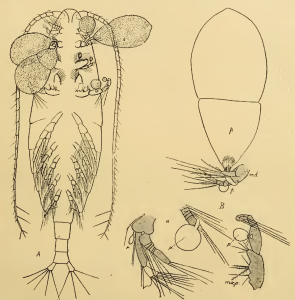Ellobiopsis chattoni
Diagnosis
Diagnosis_genus: Ellobiopsis spp. are widespread, infecting several marine and freshwater copepod species; they adversely affect fertility in females (Albaina & Irigoien, 2006) and cause feminisation in males (Théodoridès, 1989; Shields, 1994). This genus share a characteristic morphology with a well-defined stalk, a trophocyte and one (E. chattoni) or two (E. elongata) gonocytes. Firstly, a dispersion phase, consisting of spores which settle onto the setae of the new host’s appendages, where they metamorphose into trophocytes that extrude a root-like organelle through the copepod’s cuticle. When the parasite body reaches a certain size, it becomes transversally septate and forms the gonocyte (sporogenetic stage) in the distal segment. The distal gonocyte becomes granulated and leads progressively to the formation of small groups of pre-spores that fall from the segregating mass. Each bud undergoes a series of divisions to form spores. Although the spores were reported to be flagellate (Shields, 1994), the mechanism of dispersion and motility of the spores remains unknown.
Diagnosis_Species: Parasite of Calanus helgolandicus. Young stage ellipsoidal, attached by a fibrillar peduncle that deeply penetrates inside the host cuticle, but do not ramified. Mature trophonts are piriform, 700 µm long and 250 µm wide.
Body_trophont_length: 700 µm
Body_trophont_wide: 250 µm
Sequence_SSU: FJ593705-FJ593708
Etymology
Ellobiopsis: έλλόβιον: earring in greck.
chattoni: In honor of Pr Chatton, specialist of dinoflagellate parasites.
Type species
This is the type species of the genus.
Type illustration / Type locality / Type specimen
Type host: Calanus helgolandicus
Type locality: Banyuls-sur-mer
Ecology
Multiple infections frequent, with parasites having different maturation stages.
Substrate: epizoic
Sociability_adults: gregarious
Salinity: marine
Life cycle
Generation: <1 month
Symbiont: horizontal
















